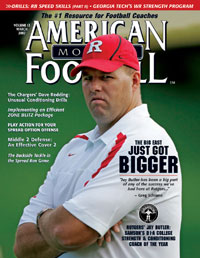AMERICAN FOOTBALL MONTHLY THE #1 RESOURCE FOR FOOTBALL COACHES
Article CategoriesAFM Magazine
|
Play Action to Complement your Spread Option Offenseby: Nathan M. CochranAsst. Head Coach/Offensive Coordinator, Blackburn College © More from this issue At Blackburn College, we employ the Spread Option offense made famous by teams like the United States Air Force Academy and the United States Naval Academy. This offense fits our program due to three main factors: time constraints due to our work program (Blackburn College is a “Work College” – all students have a job on campus), size of the athletes we can recruit at Blackburn (Division III), and the type of high school programs in our general recruiting area. Since the Spread Option offense is predominantly run-oriented, we spend most of our practices perfecting the Triple-Option. Due to our limited practice time, we try not to complicate our passing game. Also, the use of play action passes keeps our blocking schemes simple for the offensive line. In this article you will learn several play action passes that have worked well for....The full article can only be seen by subscribers. Subscribe today!
|
|
|||||||
| HOME |
MAGAZINE |
SUBSCRIBE | ONLINE COLUMNISTS | COACHING VIDEOS |
Copyright 2025, AmericanFootballMonthly.com
All Rights Reserved





